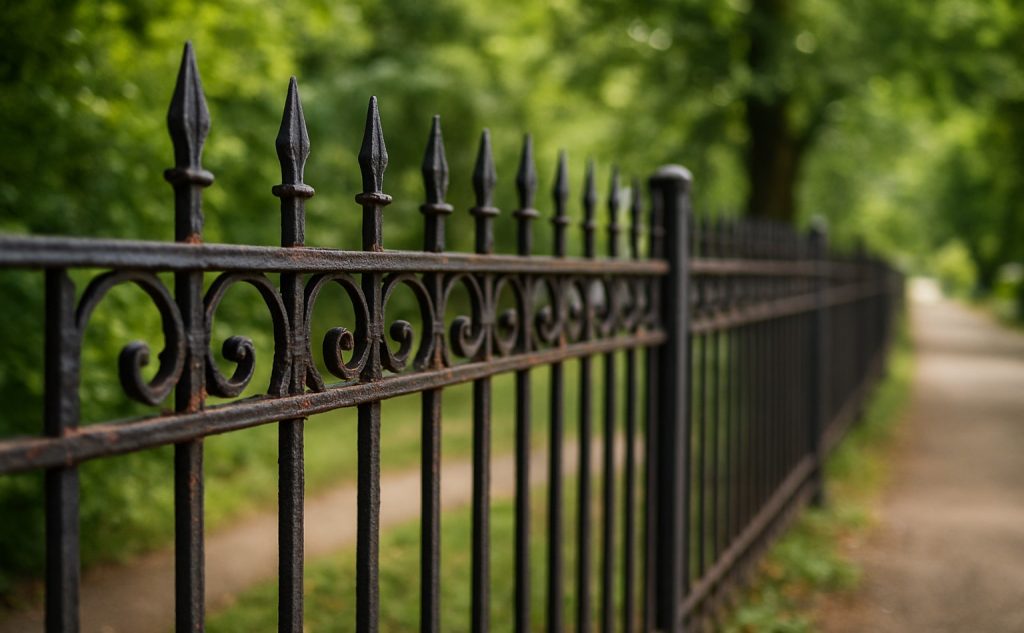Preventive Maintenance for Iron Fences is essential for property owners who value security, elegance, and long-term durability. Iron fences remain a timeless choice, but even the strongest materials require ongoing attention. Without proper care, rust, corrosion, and structural damage can shorten the lifespan of an otherwise reliable investment. This article explores the most effective strategies to keep iron fences strong, beautiful, and functional for decades.
Why Preventive Care is Essential
Iron fences endure harsh conditions, from extreme heat to freezing winters. Exposure to rain, snow, and humidity creates the perfect environment for corrosion. Regular preventive care stops small issues from becoming costly repairs. Well-maintained fences not only last longer but also enhance curb appeal and protect property value.
Cleaning: The First Line of Defense
One of the simplest yet most effective maintenance tasks is cleaning. Dust, grime, and industrial pollutants stick to iron surfaces and accelerate rusting.
Use mild soap and warm water to wash the fence twice a year.
Avoid abrasive cleaners that damage protective coatings.
Rinse thoroughly and dry completely to prevent water stains.
Cleaning also gives you the chance to inspect the fence closely, spotting weak points before they grow into structural problems.
Rust Prevention Strategies
Rust is the greatest enemy of iron fencing. To prevent it:
Apply a rust-inhibiting primer before repainting.
Use high-quality exterior paint to protect the surface.
Check for scratches or exposed areas where corrosion might begin.
A fresh coat of paint every 3–4 years is one of the most cost-effective ways to protect your fence. For homeowners considering a stronger and more professional installation, a wrought iron fence in Chicago provides both elegance and durability, but it also requires proper preventive maintenance.
Seasonal Inspections
Different seasons create unique risks for iron fences:
Spring: Check for cracks or frost-related damage.
Summer: Inspect fading paint caused by intense sun.
Fall: Remove leaves and debris that trap moisture.
Winter: Ensure snow and ice do not accumulate at the base.
Making inspections a seasonal routine helps identify problems early, preventing expensive replacements.
Structural Reinforcement
Preventive maintenance also means reinforcing the fence’s structure.
Tighten loose screws or bolts regularly.
Straighten leaning posts before they weaken further.
Repair bent panels immediately to avoid spreading damage.
Keeping the framework secure ensures the fence continues performing its protective role.
Caring for Gates and Hinges
If your iron fence includes gates, hinges, or locks, these components demand extra attention.
Lubricate hinges and locks at least twice a year.
Use weather-resistant grease to avoid stiffness or squeaking.
Check alignment to prevent stress on the iron frame.
Proper care of moving parts ensures smooth functionality and extends the life of the fence.
Landscaping and Environment
The surrounding environment often contributes to fence damage:
Trim plants and vines that trap moisture against iron.
Adjust sprinklers to avoid constant water contact.
Maintain proper drainage to prevent puddles near posts.
Integrating fence care into landscaping routines creates long-term protection.
Cost Efficiency of Preventive Care
Replacing iron fence sections is far more expensive than maintaining them. Preventive care—like repainting and rust removal—saves money and keeps your fence strong. Over time, these small tasks pay for themselves by avoiding large-scale repairs.
Sustainable Maintenance Practices
Eco-friendly care options are increasingly available:
Choose water-based anti-rust coatings.
Use biodegradable cleaning products.
Recycle damaged iron sections responsibly.
These practices extend fence life while protecting the environment.
Comparing With Other Fence Materials
Iron fencing is not the only durable option. Property owners often compare it with other materials:
Steel fencing solutions: Similar in strength and appearance, steel requires preventive maintenance much like iron, especially against corrosion.
Aluminum fences: Lightweight and naturally resistant to rust, aluminum requires less painting but still benefits from regular inspections.
When Professional Help is Needed
Some maintenance tasks are best handled by experts:
Large-scale corrosion across multiple sections.
Realignment of structural posts.
Welding or full restoration projects.
Hiring professionals ensures that the fence remains safe, durable, and visually appealing.
External Resources for Guidance
For further reading, here are two reliable sources to strengthen this topic:
National Park Service: Caring for Historic Iron – official preservation guide.
https://www.nps.gov/tps/how-to-preserve/cast-iron.htmAmerican Galvanizers Association – Corrosion Protection Guide – technical insights into protecting metals from rust.
https://galvanizeit.org/hot-dip-galvanizing/how-long-does-hdg-last
Conclusion
Preventive maintenance for iron fences is not only about appearance—it is about longevity, safety, and protecting property value. By committing to cleaning, rust prevention, seasonal inspections, and sustainable practices, homeowners ensure their fences remain reliable and elegant for decades. Whether compared with steel or contrasted against aluminum, proper care proves that iron remains one of the most dependable materials. And for property owners seeking long-term reliability, choosing the Best Commercial Fence Chicago IL reinforces the importance of preventive maintenance in maximizing investment.

